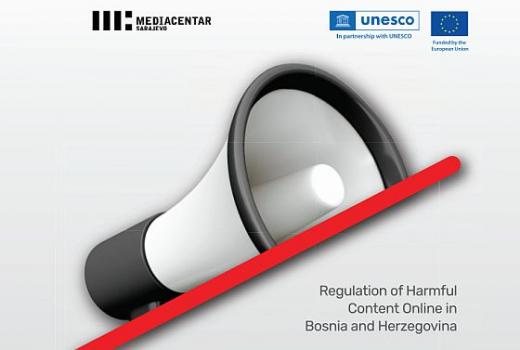Regulation of Harmful Content Online in Bosnia and Herzegovina

Regulation of Harmful Content Online in Bosnia and Herzegovina
Anida Sokol, Maja Ćalović
Publisher:
MEDIACENTAR Sarajevo
2022
The study Regulation of Harmful Content Online in Bosnia and Herzegovina: Between Freedom of Expression and Harms to Democracy is part of the UNESCO project Social Media 4 Peace, funded by the European Union, whose aim is to strengthen the resilience of societies to potentially harmful content spread online, while protecting freedom of expression and enhancing the promotion of peace through digital technologies, notably social media.
The study gives an overview of types of harmful content and their main target groups, and presents the legislative, regulatory and self-regulatory frameworks against harmful content online in Bosnia and Herzegovina. The study also looks at the obstacles in implementing the available frameworks in Bosnia and Herzegovina and their alignment with international standards, and provides recommendations or their improvement.
There are no unanimous definitions of what is considered harmful since the concept of harm is subjective and depends greatly on the context and culture, and can be different among states. Illegal harmful content is content that is not compliant with legislation, while potentially harmful content might not be prohibited, but can harm groups and individuals. This study focuses on illegal content and potentially harmful content, taking into consideration the delicate political situation, the difficult war heritage and the existence of divisive ethno-nationalistic rhetoric in Bosnia and Herzegovina. The study focuses only on harmful content that can thwart democratic processes, hamper citizens’ ability to take informed actions and impede reconciliation.
The study specifically focuses on five types of harmful content: a) hate speech and hate narratives; b) denials of war crimes and glorification of war criminals; c) ethno-nationally and/or politically biased media reporting; d) disinformation; and e) attacks, threats and smear campaigns against individuals. After giving overviews of the five types of harmful content, their targets and consequences, the following chapters are dedicated to the legislative, regulatory
and self-regulatory frameworks for the five types of harmful content, how effectively they are used online, what the major obstacles are in their implementation and to what extent they are aligned with international standards. The study also addresses the practices of the courts, the Communications Regulatory Agency of Bosnia and Herzegovina, the Press Council of Bosnia and Herzegovina and other relevant actors in countering harmful content. The final parts of the study are dedicated to the community guidelines of social networks and examples of frameworks in other countries.
The scope of harmful content online in Bosnia and Herzegovina is worrying and calls for a comprehensive response. The study emphasizes the need to safeguard freedom of expression and to find responses and practices that are aligned with international human rights law and that do not chill or censor online speech or discourage the flow of diverse sources of information and opinions.
Publication is available here.




